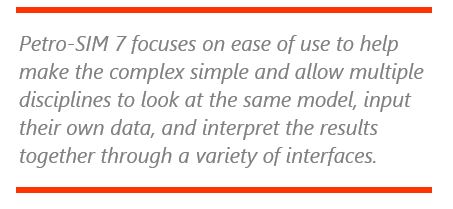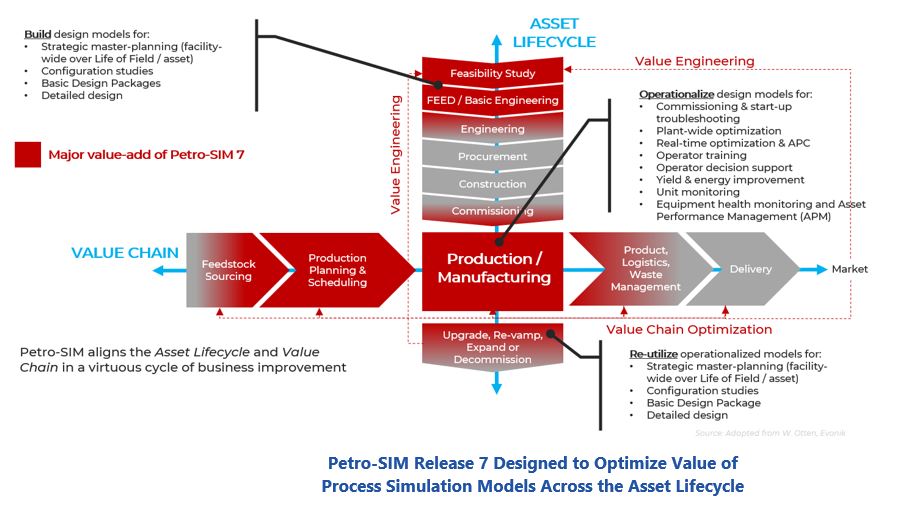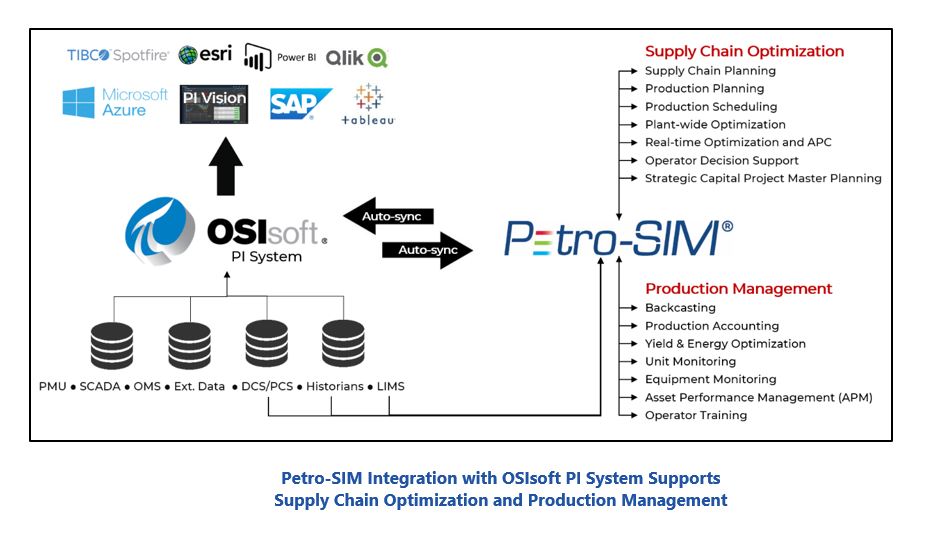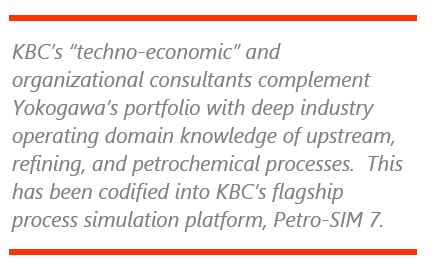Overview
ARC Advisory Group learned in a recent briefing that KBC has completed a major redesign of its flagship  engineering simulation software platform, Petro-SIM. KBC designed release 7 of Petro-SIM for industries focused on what it refers to as “value engineering” and “value chain optimization.” According to company executives, it allows asset owners and operators across upstream and production, midstream gas processing and LNG, and downstream refining and petrochemicals to leverage process simulation models across the asset lifecycle. The goal is to optimize the total cost and ownership value of process simulation models.
engineering simulation software platform, Petro-SIM. KBC designed release 7 of Petro-SIM for industries focused on what it refers to as “value engineering” and “value chain optimization.” According to company executives, it allows asset owners and operators across upstream and production, midstream gas processing and LNG, and downstream refining and petrochemicals to leverage process simulation models across the asset lifecycle. The goal is to optimize the total cost and ownership value of process simulation models.
Why KBC Adopted This Approach
KBC understands that asset owners and operators welcome opportunities to leverage their significant investments in process simulation models across the asset lifecycle. The traditional mainstay of the process simulation market has been the front-end engineering design (FEED) phases of the asset lifecycle. Owner-operators use steady-state and dynamic models for plant configuration, equipment sizing, rating and costing. Most plants have a process simulation model of the plant, either created during or after the FEED phase. However, in many cases, unit engineers have limited their use of process simulation models to troubleshoot operational issues and investigate operational improvements.

To pursue safe, reliable and profitable operations, unit engineers often consider likely plant operating scenarios. Ideally, they then use process simulation models to perform what-if scenario analysis to develop the optimum operating conditions/plan. However, KBC identified what it believes to be several problems with this approach:
- When competent engineers have the time to focus on a specific area, they can usually identify improvements. However, unit engineers have many calls on their time of which simulation and optimization are only a part. Often, when they do have time, they spend most of it getting the model up to date. Then, a higher priority activity comes along, and they must put that work aside.
- When actioning improvements, operators lack confidence in the results of the ad hoc model.
- Simulation models are often out of date and do not reflect current operations or configuration.
All this slows the rate of change or hampers improvement. Often, the unit engineers stop using the model altogether, which results in missed opportunities for optimization, business improvements, and profits.
Petro-SIM Designed to Enable Value Engineering
For many years, the upstream and downstream oil & gas industries have taken advantage of Petro-SIM’s steady-state functionality. But this applied largely only in the early stages of the asset lifecycle for conceptual studies, basic design, operator training packages, and other engineering work. As ARC learned, key improvements in Petro-SIM 7 that support value engineering include:
- Upstream. Native integration of Petro-SIM with KBC’s Maximus compositional thermal hydraulic steady-state pipeline network simulation software, and Multiflash PVT (pressure-volume-temperature) modeling software package, which many consider to be a defacto industry standard. This integration helps ensure rigorous representation of wells, chokes, flowlines, and a wide range of processing and power generation equipment in the Petro-SIM flowsheet. This integration is key for right-sizing well deliverability and field designs to process facilities (including power generation), to produce the limit over the life of the field. Consistent fluid characterization and thermodynamic methods throughout the integrated model, including equipment sizing, helps eliminate barriers and reduce workload in manual checking of results.
- Dynamics. A key development in Petro-SIM 7 is integration with Yokogawa’s OmegaLand operator training simulator (OTS) software. Here KBC has provided pre-built, extensible templates to simplify integrating Petro-SIM dynamic models with the OmegaLand environment. This helps ensure that all key variables are linked.
- User-driven data exchange with third-party engineering design packages. Petro-SIM’s open architecture has enabled greater flexibility and introduced new, user-driven-methods for getting the right information in and out of Petro-SIM when interfacing with users, Excel or third-party design packages. This has enabled integration with: Petro-SIZE for process equipment sizing and rating calculations; Cost Engineering’s Cleopatra Enterprise for cost estimation; HTRI’s XSimOp ShellTube, in addition to pre-existing integration with HTRI’s Xchanger Suite; and MySep for design, evaluation and simulation of separation vessels such as separators and scrubbers. These new integrations complement Petro-SIM’s existing flare design, vessel depressurization and blowdown capabilities, through Flaretot.
-
Workflows, personas, case management, and collaboration. According to the company, Petro-SIM’s built-in workflow engine can help manage risk and enhance speed and efficiency when executing repetitive engineering tasks. It can help drive standardization in how process simulation executes through user-specific rules and engineering standards. Case management capabilities allow users to organize cases into folders, with the added ability to publish and subscribe over a security mechanism. This also allows multiple disciplines to look at the same model, input their own data, and interpret the results collaboratively through a variety of interfaces.
According to the company, the goal of these enhancements is to deliver speed and rigor in engineering activities so that users never have to compromise on the quality of results.
Petro-SIM 7 Designed to Drive Value Chain Optimization
For over a decade, Petro-SIM’s open architecture has allowed it to consume real-time operations data from sites’ DCS, Historian (OSIsoft PI or other) and LIMS to deliver real-time, high-fidelity virtual representations of hydrocarbon molecule transformation and associated plant operating conditions. This type of information can provide operations and planning groups with powerful tools for unit monitoring and generating LP data. Many people today would consider this to be a digital twin. Petro-SIM’s fully historized relational database to which it writes all its outputs helps make this possible. Key improvements in Petro-SIM 7 that support value chain optimization include:
- Analytics data quality management. Petro-SIM is designed to automatically validate mass balances and reconcile process data. Analytics applications take in or compare measured vs. simulation model vs. linear programming (LP) model performance. According to the company, this helps close the value gap across supply chain and/or production management activities. These outputs are then available for consumption through the OSIsoft PI System and various other analytics and visualization tools, including KBC’s private cloud-based SaaS application, Operating Goals Manager (OGM), to measure conformance of indicators against defined goals and constraints.
- Historical data mining. All Petro-SIM outputs are written to its fully historized relational database. Petro-SIM 7 also includes enriched Microsoft Excel tools for managing Petro-SIM models, charting and managing results and has a natively integrated data querying engine to enable users to mine its database and explore different database cases. This constitutes a rich source of process data on which to base other analytics initiatives. The Excel integration enables users to generate equipment datasheets for any object within the Petro-SIM case. This is the same for heat and material balance reports with custom engineering templates. The new Data Set Analysis utility allows users to compare measurement values to calculate results across a wide number of data sets. It can be used independently or run as part of the calibration application where it will treat data sets as cross-predict cases.

- Continuously synchronized plant and data model. As well as being able to consume real-time data from the OSIsoft PI System and other historians, Petro-SIM 7 can write all outputs back into the PI System in real time to amplify the quality of data in the PI System. According to the company, the tight integration between Petro-SIM and the PI System enables continuous synchronization of both systems through automated creation of PI Asset Framework (PI AF) templates and elements within the PI System, from Petro-SIM, and automated update of the PI AF elements if the Petro-SIM model changes. The synchronization also entails automated population of the Petro-SIM model with current PI System data. According to the company, this allows Petro-SIM 7 to both serve as a molecular-enabled digital twin for monitoring and surveillance and then underpin supply chain optimization and other advanced applications and services by having an always-validated model available. According to the company, through this mechanism, Petro-SIM 7 can provide a single source of the truth across the full stream for how molecules and operating conditions behave at the unit- and asset-wide level; thereby providing actionable insights into production activities that can drive convergence in decision-making and action across organizational silos.
- Cloud-based hosting. Petro-SIM 7 is containerized and fully scriptable for cloud-based hosting by market-leading IIoT platforms.
Conclusion
Owner-operators seek suppliers with deep understanding of the intricacies of how they should run their equipment, plant, and facilities. This provides the fundamental basis for digitally enhancing current processes, reducing manual effort and errors, and – only if needed - creating new work processes. This industry  operating domain knowledge and know-how around business value drivers is critical for driving change on the front line and helping ensure that digitalization efforts deliver the desired outcomes.
operating domain knowledge and know-how around business value drivers is critical for driving change on the front line and helping ensure that digitalization efforts deliver the desired outcomes.
KBC has established a solid reputation as a trusted, global supplier of optimization technologies and associated services. They have been actively codifying rich industry domain knowledge into process simulation software since 1981.
Today, KBC’s “techno-economic” and organizational consultants complement Yokogawa’s portfolio with deep industry operating domain knowledge of upstream, refining, and petrochemical processes. This domain knowledge has resulted in KBC’s flagship process simulation platform, Petro-SIM 7, a versatile and solid foundation for knowledge capture across the full asset lifecycle.
KBC domain expertise in the energy and chemicals verticals, combined with Yokogawa’s well-proven automation, safety, and connectivity infrastructure, are helping the company transform its customers’ businesses. This is consistent with Yokogawa’s Synaptic Business Automation concept and more recent OpreX-related activities.
KBC's consultants have deep domain expertise and extensive C-level customer relationships, which is expected to increase Yokogawa’s digital mindshare among these key decision makers and help it further its goals of being a trusted partner for customers. KBC’s value proposition around lifecycle simulation and operationalizing simulation models into real-time digital twin is compelling.
Petro-SIM, Maximus, Multiflash, and Petro-SIZE are registered trademarks
of KBC. All other trademarks mentioned in this report are the property of their
respective owners.
ARC Advisory Group clients can view the complete report at ARC Client Portal
If you would like to buy this report or obtain information about how to become a client, please Contact Us
Keywords: Engineering, Simulation, Process, Optimization, KBC, Petro-SIM, Maximus, Multiflash, Digital Twin, Yokogawa, ARC Advisory Group.





